The range of school experiments being done on the microscale is growing. Reaction rates, relative atomic mass determinations and syntheses of organic and inorganic compounds, from Key Stage 3 through Key Stage 4 to A-level, are all proving to be successful.
-
Experiments done on the millimolar scale are fast, safe and cheap, there is less waste and less mess
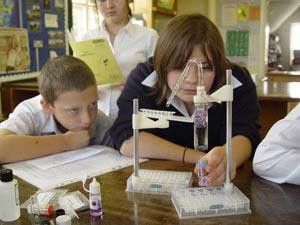
There are several good reasons for using microscale apparatus and doing reactions on the millimolar scale or less - health hazards are virtually eliminated, the reactions are quicker, cheaper and there is less waste and less mess to clear up.1 From my own point of view I also see it as a way of making practical work more accessible to more students. Moreover, each student can work individually, which encourages them to be independent and take ownership of their work. Since we acquired class sets of microscale apparatus - Combostills, Comboplates, and microburettes and micropipettes - I have used this approach with KS3, KS4, AS and A2 students. In this article I want to give you an idea of the range of practicals that can be done using this approach.
Key Stages 3, 4, and 5
At this age range we have used microscale apparatus to prepare salts, gases and do titrations.
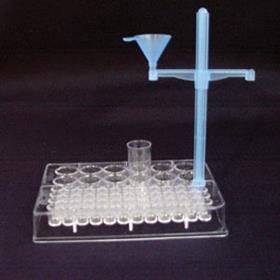
Salt preparations
Figure 1 shows the apparatus we use for preparing copper sulfate (and other soluble salts) on the microscale. The teacher heats up the sulfuric acid in a beaker and then dispenses it, 2cm3 at a time, into the wells of the Comboplates. The students add the copper oxide until the solution is saturated, and then filter through a small filter paper and funnel into another well. The result is a blue solution of copper(ii) sulfate. There are no accidents and it's easy to clear up. The concerns I have had in the past over my less able students having to heat large amounts of these chemicals are no longer a problem. I find that the microscale experiment can be done across a large ability range and even with 'difficult' classes.
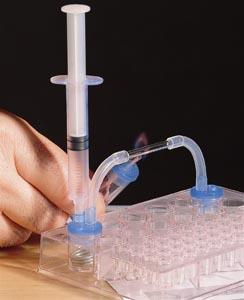
Microscale gas preparations
Figure 2 shows the microscale apparatus for preparing gases and then either testing them or passing them over other substances. The gas is prepared in one large well on the Comboplate and then passed through the apparatus by gently pushing down the syringe. Hydrogen can be prepared from magnesium and 1 mol dm-3 hydrochloric acid by using this apparatus. We have reduced copper oxide with hydrogen - the oxide is placed in the combustion tube in the middle of the wells. We have also prepared and investigated oxygen, carbon dioxide, hydrogen chloride, and chlorine (at A2-level) using this method.
Titrations
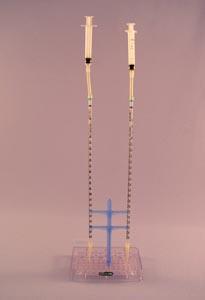
Figure 3 shows the apparatus for microtitrations. The micropipette is also used as a microburette. The micropipette dispenses small volumes (ca 1 cm3) of, for example, sodium hydroxide solution into one of the larger wells. The syringe is used to regulate the volume of solution. Small drops of indicator are added using a micro version of a plastic dropper. The microburette is positioned above the well and the solution added until the appropriate colour change occurs. At AS- and A2-level, rough titrations can be done by adding 0.1 cm3 at a time. Fractions of drops can be taken from the tip of the microburette by using a plastic microspatula. The microburettes read to 0.001cm3 and can add up to 2 cm3 to the well before refilling. We use discarded white laminated sheets as a background to help us see the colour changes. We have also used this method for making ammonium sulfate (KS3), for quantitative investigations of acids and bases (KS4), and for potassium manganate(vii) titrations (KS5).
Investigating reaction rates (KS4)
Figure 4 shows the microscale apparatus we now use for investigating rates of reaction. Where we once used 25 cm3 of acid, we now use 2 cm3, and 1g of marble chips are replaced with individual marble chips (or multiples thereof). The carbon dioxide given off is measured by the volume of water displaced from the conical flask into the measuring cylinder. The results are no different to those obtained if gas syringes and gram quantities of marble chips are used.* By assuming each marble chip is of the same size, two marble chips will have twice the surface area as one marble chip and therefore the initial rate with two marble chips should be twice that with one marble chip. When the number of marble chips is plotted against volume of gas evolved in one minute, we get a straight line.
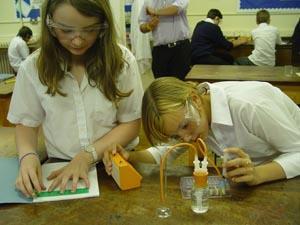
AS and A2 chemistry
AS- and A2-level students enjoy microscale work because they are quick to do and clear up. In one lesson, for example, you need set aside 20 minutes for the practical, which leaves you with time to give a talk or to discuss the practical.
Determination of the relative atomic mass of magnesium
This experiment uses 0.5 cm, 1.0 cm and 1.5 cm lengths of magnesium ribbon. The masses of these lengths cannot be weighed. To get around this problem we weigh a 10 cm length of magnesium ribbon. This value is then used to estimate the lengths of Mg, ie 0.5 cm, 1.0 cm etc. The magnesium is dropped into 2 cm3 of hydrochloric acid in one of the wells of the Comboplate and the volume of hydrogen evolved is measured using the displacement of water from a conical flask as before. The students then plot the mass of magnesium against the volume of gas produced, and read off the value for the mass of magnesium that produces 24 cm3 of hydrogen gas. So the mass of magnesium that gives 2400cm3 (and thus the approximate relative atomic mass) can be calculated. A gas-syringe works just as well but a conical flask and tubing is cheaper, and an under-funded chemistry department is more likely to have a class set of conical flasks than gas syringes.
An OCR AS-level practical, which is used to assess the Implementation, Analysis and Evaluation criteria, involves finding the relative atomic mass of calcium by two different methods. It is an excellent experiment but done on the laboratory scale students usually work in pairs and use large measuring cylinders, lots of water, large troughs and burettes. In contrast, by using microscale apparatus they can do the same experiment individually. Students weigh out 0.04-0.06 g of calcium, react it with water and measure the volume of hydrogen gas released using the displacement of water from the conical flask as before.
Ca(s) + 2H2O(l) → Ca(OH)2(aq) + H2(g)
This gives a value for the relative atomic mass of calcium by one method. The Ca(OH)2 remaining is then titrated against 2mol dm-3 hydrochloric acid, which allows the student to determine the relative atomic mass by a second method.
Ca(OH)2(aq) + 2HCl(aq) → CaCl2(aq) + 2H2O(l)
In two hours students can do about six determinations.
The acid thiosulfate reaction
This has long been a standard reaction for investigating rates of reaction.
Na2S2O3(aq) + 2HCl(aq) → 2NaCl(aq) + H2O(l) + SO2(aq) + S(s)
The rate of reaction is determined by measuring how long it takes for the precipitate of sulfur produced to obscure a cross on a piece of paper or a coin placed on a white tile.
Using microscale apparatus, the experiment requires only minute quantities of thiosulfate and acid and thus avoids the smell of sulfur dioxide which would normally pervade the laboratory when up to 50 cm3 of reactants are used. On a microscale the only equipment needed is the Comboplate and two micro droppers (known as Propettes). This time the small wells are used. Instead of cm3 quantities, the amounts are measured in terms of numbers of drops and serial dilutions along one row of small wells (see Table 1). The bottoms of the wells are transparent and the cross on the paper is seen through them. The Comboplate is placed over a laminated sheet with the cross on it and the reaction started by adding five drops of 2 mol dm-3 hydrochloric acid. The advantages of this method are that several experiments can be done at the same time and very little sulfur dioxide gets into the atmosphere. I have used this method at Key Stage 4 when doing rates and at A2-level as a way of looking at the order of reaction for thiosulfate and acid. Identical patterns are obtained as those for normal scale - first order with respect to thiosulfate and (at this concentration of acid) zero order with respect to acid.
The plastic Comboplates are virtually unbreakable but because they are plastic they cannot be heated directly. To measure the effect of temperature on this reaction place 1.5 cm3 of sodium thiosulfate solution (40 or 80 g dm-3) and 1 cm3 of distilled water in one of the large wells. Now heat a nickel spatula in a Bunsen flame and dip carefully (without touching the sides of the well) into the solution. Measure the temperature using a microscale thermometer and when the correct temperature is reached, start the reaction using five drops of 2 mol dm-3 hydrochloric acid. The temperature is increased by 10°C, the time taken to obscure the cross is halved.
Organic reactions
Figure 5 shows the Combostill in distillation and reflux modes. Using this piece of apparatus many organic experiments can be done, each one taking less preparation and time than would be required if the same experiment was done using Quickfit apparatus. The microscale reaction takes place in an inner reaction vessel that has a capacity of ca 2.5 cm3. A small methylated spirit burner is used for heating an outer vessel containing silicone oil which in turn heats the inner reaction vessel. My AS-level students have used this equipment to prepare ethyl ethanoate. The reaction mixture of ethanol and ethanoic acid along with a few drops of the concentrated sulfuric acid catalyst are placed in the inner vessel. Since the first part of the experiment requires refluxing, a vertical glass column is used along with small glass balls on which the vapours can condense. The refluxing takes about five-10 minutes. After this the apparatus can be adapted for distillation and the ethyl ethanoate distilled over. There is enough product to smell and give an oily layer on water.
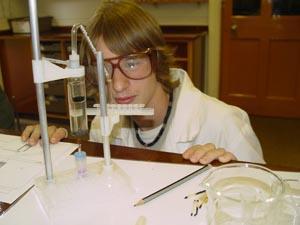
The Combostill can be adapted for other preparations. For example, when alcohols are oxidised using acidified potassium dichromate(vi) the alcohol and potassium dichromate(vi) are added to the hot acid in the reaction vessel via a dropping funnel. For the dropping funnel a syringe is inserted through the opening where the Combostill has room for a thermometer (see Fig 5). Using this apparatus enough aldehyde/ketone is produced to give a precipitate with 2,4 DNPH and, if the product is an aldehyde, sometimes enough to give a silver mirror with Tollens' reagent.
Other preparations we have done using this apparatus include:
- cyclohexene from cyclohexanol;
- 1-bromobutane from butan-1-ol;
- ethanoic acid from ethanol;
- aldehydes and ketones from alcohols;
- esters.
How do you know the quantities to use in these reactions? Think microscale. Scale down from 50 cm3 to 2.5 cm3. How many 'microspatula scoops' are needed for 1 g of solid and how many drops from the Propette give 1 cm3- Answer these questions and then adapt.
Be adventurous
This is not an exhaustive list of experiments you can do using this apparatus and if you try it out you will discover that you can do a whole range of practicals safely with young people of all ages and abilities. I am not the bravest or the most innovative teacher but it has given me a tremendous boost in terms of what I can do in the classroom.
Dr Mike Wooster is head of science at Downham Market High School, Bexwell Road, Downham Market, Norfolk PE38 9LL.
References
- S. Breuer, Educ. Chem., 1991, 28 (3), 75.
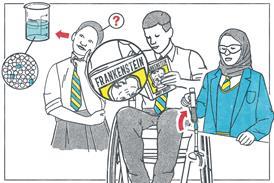
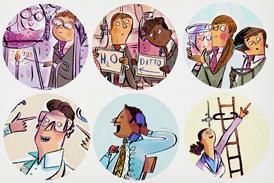







1 Reader's comment